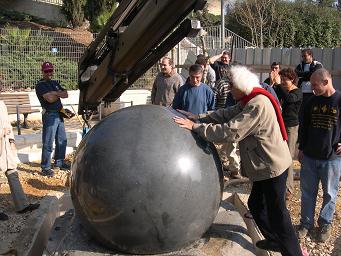How can a small water pump lift a 6 ton rock?
On December 26, 2006 we reported to you about A huge stone ball weighing 6 tons and floating on the surface of the water came from China to the Science Museum in Jerusalem And any child can spin it. We received inquiries on talkback and by email about how this miracle is possible. We contacted the museum's management and received the following response:

How can a small water pump lift a 6 ton rock? The answer lies in pressure - a small pressure acting on a large area exerts a large force which is enough to lift the stone. Let's say, for example, that a force of 10 newtons acts on each square centimeter (a force equal to the weight of one kilogram) and that the total area is 50 square centimeters, then the total force will be 500,000 newtons (equal to a weight of 50 tons!). The force acting on the area is actually equal to the product of the pressure on the area.
Who exerts pressure? Air exerts pressure and water also exerts pressure. The pressure exerted by the air is approximately equal to the weight of one kilogram per square centimeter (one atmosphere). Why don't we feel this pressure? Usually the pressure acts on bodies in a balanced manner from all sides so that its effect is not felt. But if the pressure on one side of a certain body is greater than that acting on the other sides, a force will be exerted that can move even very heavy bodies. Evidence of the power that air can exert can be found by pumping air out of an empty soft drink bottle. The air pressure outside the bottle is usually equal to that inside. When the balance is disturbed (by the suction), the air outside the bottle exerts a greater force towards the inside of the bottle and the bottle is crushed.
Hydraulic pistons, such as those used in elevators (and the one in the museum), work on the same principle: the pressure acting on a large area of the piston causes a large force to be used that can lift the elevator. The same principle, but in reverse, allows a layman to lie on a bed of nails without being injured. Its weight is distributed over a large number of nails so that each of them exerts only a small force on the fakir's body - a force that is not enough to penetrate through his skin. It would be quite difficult to convince a fakir to lie on a bed of nails with only one nail.
Our rolling stone is placed on the circumference of a stone "saucer". Water is pumped into the "saucer" and fills it, creating a kind of pool under the stone. The pressure in the resulting pool increases until the force applied to the stone is great enough to lift. The area at the bottom of the stone on which the water pressure acts is large enough that a pressure of 0.8 atmospheres (about a weight of 800 grams per square centimeter) is enough to lift the stone. For comparison, the water pressure that reaches our homes is about 3-4 atmospheres. When the stone rises a little, the water bursts through the narrow crack created in the circumference of the "saucer"? And the pressure necessary to keep the stone "floating" on a thin "carpet" of water is maintained (the stone, of course, does not float according to Archimedes' law of buoyancy).
In the situation created, the friction between the stone and the water is very small and it is possible to turn the stone by hand. It is understood that the large mass of the stone means that a lot of force is needed over a long period of time to start spinning it, to change the direction of its rotation or to stop it.
The caption that appears near the exhibit in the Science Museum
stone ballAlthough the weight of the granite ball is six tons, it can be rotated in any direction.
The ball rests on the circumference of a stone saucer. Water that is "pushed" to the saucer, fills it and creates a pool under the stone. As you "push" the water harder, the pressure increases, until the force exerted on the stone ball is great enough to lift it slightly. When the stone rises a little, the water is pushed through the narrow crack between the sphere and the circumference of the saucer, and the pressure necessary to keep the stone "floating" on the water is maintained.
In the situation created there is almost no friction between the stone and the water and you can turn the stone by hand. The large mass of the stone requires the application of force, and slowly the ball will stop or change its direction of rotation.
Thanks to Dea Brockman, spokeswoman for the Science Museum

2 תגובות
And in a physical explanation from another aspect:
The friction of the ball mover is greater than the friction at the bottom of the granite ball.
Kudos to you for taking the trouble to clarify the issue!